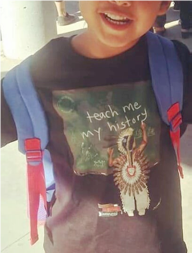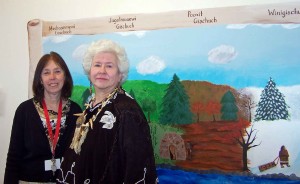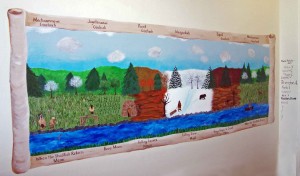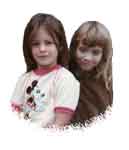
Native American Teacher / Parent Resources
There are several articles on this page, a classroom activity and lots of links you can copy into your browser.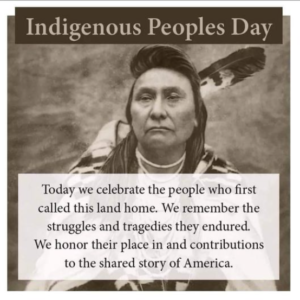
5 Ideas for Indigenous Peoples Day from the Smithsonian
https://www.smithsonianmag.com/blogs/national-museum-american-indian/2020/10/07/indigenous-peoples-day-2020/?utm_source=smithsoniandaily&utm_medium=email&utm_campaign=20201007-daily-responsive&spMailingID=43634581&spUserID=NzQwNDU3OTcxMDAS1&spJobID=1860590757&spReportId=MTg2MDU5MDc1NwS2
Teachers & Parents https://www.fastcompany.com/90356160/molly-of-denali-podcast-native-stories-with-native-voices?fbclid=IwAR2VHTdsLgG4qyPwCvPXBAN0OF94fWk4l3FJhKvogtjN7pkZ76H1jlFlKXg
| Joy Harjo Becomes the First Native American U.S. Poet Laureate |
| Harjo – a longtime poet and member of the Muscogee Creek Nation – is known for infusing Indigenous social justice issues into her poetry.
Her poem “Remember” was featured in Rethinking Columbus, edited by Rethinking Schools editors Bill Bigelow and Bob Peterson. Rethinking Columbus includes more than 80 essays, poems, interviews, historical vignettes, and lesson plans to critique the myth of Columbus and center the lives of Indigenous people in the curriculum. About her appointment as Poet Laureate, Harjo told NPR: “It’s such an honoring for Native people in this country, when we’ve been so disappeared and disregarded.” We are inspired to hear of Harjo’s appointment and wish her success raising consciousness about Native issues and spreading the gift of poetry. – Rethinking Schools. |
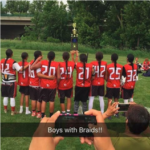 2017 SD State Champs!! #themboyswithbraids ##LightningStickLacrosse
2017 SD State Champs!! #themboyswithbraids ##LightningStickLacrosse
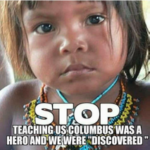
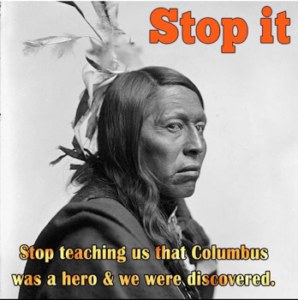
What are YOUR plans for Indigenous Peoples Day?
Read below.
Dr. Nancy Yard Holland Township School District & Carla with mural in Dr. Yard’s office from When the Shadbush Blooms, 4 2015.
When the Shadbush Blooms is now a video on our Shadbush page! When the Shadbush Blooms has been reprinted as a paperback for children to enjoy! Hardback copies are still available in limited quantity, perfect for libraries, all books can be signed and dedicated from our Book for Sale page in the Shadbush section. For bulk purchases go to the publishers at leeandlow.com.
National History Day: The 2025-2026 theme is Rights & Responsibilities in History.. Go Native! For further information regarding National History Day visit their website at: http://www.nhd.org
 How will you celebrate American Indian History Month in November?
How will you celebrate American Indian History Month in November?
A Federal Bill created NATIVE AMERICAN HERITAGE DAY on the Friday after Thanksgiving! What are your plans?
Look for the following pages: Lenape Resources – Lenape history, food & more; When the Shadbush Blooms & a related Activity page; Book List; Native Inspired Children’s Poetry, Frog Poetry by children; Frog/Amphibian Information; Native Food in General; Celebrate November! – lots of resources there!
Also: Susquehannocks; Brief Overview of Native History; Loan Words/Place Names; Natural World/Conservation; Building Bridges & Culturally Responsive Curriculum; Lakota use of CRC; Boarding Schools; Census; Lewis & Clark; Unstereotyping (three parts); Costumes/Halloween; Why NO Mascots; Project Cradleboard; Powwows; More Resources; Women Authors; This day/Month in Native History; 10 Commandments (Children’s Page) and a Review of one of our school visits!
In addition: take a Colonial Quiz; a Women’s Quiz, find out about Oyate Press and read To Consider! Then you can visit the other pages! 🙂
Visit: http://www.tolerance.org/search/apachesolr_search/Native%20American
On this Page: Native vs Indian; Why Teach About Native Americans? Walk a Mile in My Moccasins & other articles.
10 Things Teachers Should Never Do When Teaching Native Kids Christina Rose Indian Country Today 8/6/14
Each year, teachers with no background or understanding of Native history, culture, or current affairs, offer mainstream and Native students damaging, stereotypical curriculum. As summer winds down and kids get ready to go back to school, let’s discuss some things teachers shouldn’t do and ways parents can help.
Don’t Ask Native Students to Speak for Their Race
Teachers often ask Native students about anything that comes up about Native Americans. Tell your child’s teachers that every tribe is different as are opinions among Indigenous Peoples, and your child cannot speak for everyone. Recommend books like 500 Nations by Alvin M. Josephy.
Don’t Have Students Make Indian Names or Animal Totems
Many teachers try to teach about Native peoples through crafts projects or assignments like letting students choose Indian names for themselves. Consider it a teaching moment and print out this letter from Wisconsin Activist Richie Plass.
Don’t Host Powwows or First Thanksgivings Without Tribal Input
Some teachers think hosting a student powwow without any tribal input is okay, and honors Native people. Approach teachers as soon as school starts and let them know you would be happy to help plan an appropriate celebration for Native American Heritage Month. If you don’t, imitation powwows with fake animal names, paper bag vests, and fake feather headdresses could happen. Direct teachers to read “The Harm of Native Stereotyping,” and “American Indian Perspectives on Thanksgiving.” RELATED: Video: Florida High School’s Horrific Display of Cultural Stupidity
Don’t Ever Tell Native Students They Are Going to Drop Out
There is no excuse for it but there are some non-Native teachers who have been known to say things like this. Many Native students report that teachers told them it didn’t matter if they attended school or got good grades, because they would fail anyway. Native students graduate and attend the best colleges in the country, some in the face of many hardships. Teachers should be supportive of all students.
 Don’t Say that Columbus Discovered America
Don’t Say that Columbus Discovered America
This should be old news by now, but non-Native teachers are uncomfortable with the truth. Tell them to do some research and even read Lies My Teacher Told Me, by James Loewen. RELATED: American History Myths Debunked: Columbus Discovered America
Don’t Use Words Like Primitive, Savage, Or Uncivilized
Please. Mainstream science is only just beginning to understand astronomy, geology, and other sciences that have been common knowledge to indigenous people for thousands of years. Is your child’s teacher not so sure about that? Show them this link to StarTeach Astronomy and their page on “Ancient Astronomy of the North American Indians.”
Check Reading Lists: Avoid Racist Commonly Used Books
Books like Little House on the Prairie by Laura Ingalls Wilder and Garth Williams and Sign of the Beaver by Elizabeth George Speare are still commonly used in the classroom and feature hateful and/or stereotypical portrayals of Native people. Other books may not be overtly offensive to an unsuspecting teacher but are still incorrect or misleading. Read “‘I’ Is Not For Indian: The Portrayal Of Native Americans In Books For Young People” on Native Culture Links before deciding to use a book in your curriculum. Teachers can also check out the American Indians in Children’s Literature blog.
Visit Oyate!! Oyate.org (see Parent/Teacher resources for more information.
Don’t Speak About Natives Only in the Past
Too many teachers are disconnected from Native peoples and have no sense of Natives in the present. If you suspect this is the case, offer to come into the classroom to do a presentation or even provide the teacher with a link to Oyate.org, purveyors of tribally approved curriculum and information. You can also recommend Native news sources.
Don’t Allow Mainstream Students to Bully Native Kids
If teachers see students doing the woo-woo thing, making fun of long hair, calling Native students by mascot names, etc., do not assume it will “toughen them up.” Bullying can result in suicide, damaged self-esteem, embarrassment and more. Teachers can use this as time to teach about diversity and respect.
Teacher Shouldn’t Assume They Know Anything About Natives
When teachers have no understanding of Native culture, they teach stereotypes. Have them contact their local tribes for speakers and be sure they have appropriate sources to get them on the right path to teaching accurately about Native peoples. Native Web Search has loads of resources. Please note there are many groups, check for accuracy before sending students into the “wild web”!
Read more at http://indiancountrytodaymedianetwork.com/2014/08/06/10-things-teachers-should-never-do-when-teaching-native-kids-156252
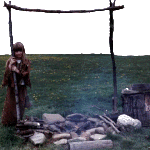
 Congratulations to Hailey Lunderman, Mississippi Choctaw/Lakota, who was recognized as Miss Softball for the State of Mississippi. The award is for the state’s top softball player in all class level of play. The sophomore from Neshoba Central High School led her team to a 5A State Title this season. She had a .508 batting average and 60 runs scored in 37 games this season. Congrats to Hailey! ONLY a sophomore! from sdc Journal #2864 5.31.13
Congratulations to Hailey Lunderman, Mississippi Choctaw/Lakota, who was recognized as Miss Softball for the State of Mississippi. The award is for the state’s top softball player in all class level of play. The sophomore from Neshoba Central High School led her team to a 5A State Title this season. She had a .508 batting average and 60 runs scored in 37 games this season. Congrats to Hailey! ONLY a sophomore! from sdc Journal #2864 5.31.13
New pages http://zinnedproject.org/posts/category/explore_by_theme/native-american
This very brief summary is designed to help teachers from perpetuating wrong information concerning the Lenni Lenape people. It can also be applied to most of the other Native People. It is important to teach that the Lenape and other Native People are human beings with many things in common with other human beings physically, but that they have different cultural ways. One should not expect to understand Native Peoples (or any other people for that matter) in order to gain respect for them. Respect precedes understanding.
Lenape means “The First People”. It is already in plural form so should not have an “s” at the end of it. The Lenape are not extinct. The Lenape of the 17th century were not the same as their ancestors hundreds and thousands of years before. Their culture had evolved through time and continues to evolve. The Europeans that came to what is now called Pennsylvania, named the main river of the Lenape, after Lord De la Warre. The word later became slurred into Delaware. The Europeans called the Lenape “Delaware”. The Lenape people are not a possession! Although some of the Lenape who left their traditional homeland did sign treaties using the term “Delaware” the people here are really still Lenape. You can find additional Unstereotyping examples on the More Resource page.
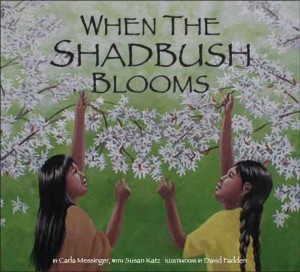 Donations are gratefully accepted to maintain and expand this website. Please send Elen an e-note with your donation. You can contribute via PayPal at our Paypal link, see the Book for Sale page. You can also purchase a signed & dedicated copy of When the Shadbush Blooms at our Book for Sale page in the Shadbush section. See Shadbush Activity Page at the top. When the Shadbush Blooms is available as a paperback!
Donations are gratefully accepted to maintain and expand this website. Please send Elen an e-note with your donation. You can contribute via PayPal at our Paypal link, see the Book for Sale page. You can also purchase a signed & dedicated copy of When the Shadbush Blooms at our Book for Sale page in the Shadbush section. See Shadbush Activity Page at the top. When the Shadbush Blooms is available as a paperback!
Links to Smithsonian’s National Museum of the American Indian. These links have resources for teachers, parents and group leaders, copy & paste them into your browser – http://nmai.si.edu/subpage.cfm? http://nmai.si.edu/education/files/thanksgiving_poster.pdf http://nmai.si.edu/education/files/SelfGuide_Beauty_en.pdf http://nmai.si.edu/education/files/NMAI_Harvest_Study_Guide.pdf
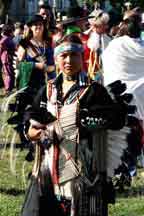 Their eyes are bright, their minds are clear and aware. Their every being speaks of strength and courage. Their souls are calm as the still waters. With pollen in hand, a prayer on their lips, they set forth on the long journey stretching away before the time. As the size words of their grandfather echoes in the hose of their minds, they walk the pollen path of beauty. They are the children of Dine. – Cecelia Nez Editing by Matthew Lewis. Sdc Journal #1040
Their eyes are bright, their minds are clear and aware. Their every being speaks of strength and courage. Their souls are calm as the still waters. With pollen in hand, a prayer on their lips, they set forth on the long journey stretching away before the time. As the size words of their grandfather echoes in the hose of their minds, they walk the pollen path of beauty. They are the children of Dine. – Cecelia Nez Editing by Matthew Lewis. Sdc Journal #1040
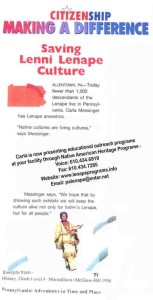 3/4/08 Carla appears in both Macmillan/McGraw-Hill & Scott Foresman Pennsylvania textbooks.
3/4/08 Carla appears in both Macmillan/McGraw-Hill & Scott Foresman Pennsylvania textbooks.
Native vs Indian Many Native Americans suggested leaving such general terms behind in favor of specific tribal designations.
As the publisher and editor of The Navajo Times, the largest Native American–owned weekly newspaper, puts it, “I . . . would rather be known as, ‘Tom Arviso Jr., a member of the Navajo tribe,’ instead of ‘Arviso, a Native American or American Indian.’ This gives an authentic description of my heritage, rather than lumping me into a whole race of people.”
A Medieval Misnomer
Indian was the name Columbus mistakenly applied to the people he encountered when he arrived in what he believed was the “Indies,” the medieval name for Asia. Introduced in the 1960s, the term Native American offered a way of eradicating confusion between the indigenous people of the Americas and the indigenous people of India. The term American Indian also served that purpose, but raised other problems: the use of Indian in any form had begun to be seen by some as pejorative. Doing Away with Cowboy-and-Indian Stereotypes Particularly in academic circles, the term Native American became the preferred term of respect, and a remedy for avoiding dehumanizing stereotypes, whether of the “bloodthirsty savage” or the Tonto-like “Noble Savage.” For a time, using Native American signaled a progressive and enlightened consciousness, in much the same way that using Asian instead of Oriental does. Use of Indian struck some as out of touch, or worse—a mark of ignorance or bigotry.
A “Generic Government Term”
But objections to the term Native American also arose. The term struck many as dry and bureaucratic, in much the same way that some dislike the Census Bureau’s use of Hispanic as an umbrella term to cover the whole of the U.S.’s diverse Spanish-speaking population. As the Bureau of Indian Affairs elaborates:
The term, ‘Native American,’ came into usage in the 1960s to denote the groups served by the Bureau of Indian Affairs: American Indians and Alaska Native (Indians, Eskimos and Aleuts of Alaska). Later the term also included Native Hawaiians and Pacific Islanders in some Federal programs. It, therefore, came into disfavor among some Indian groups.
As Christina Berry, a Cherokee writer and producer of the website All Things Cherokee, counsels:
In the end, the term you choose to use (as an Indian or non-Indian) is your own personal choice. The recommended method is to refer to a person by their tribe, if that information is known. The reason is that the Native peoples of North America are incredibly diverse. It would be like referring both a Romanian and an Irishman as European. . . . Whenever possible an Indian would prefer to be called a Cherokee or a Lakota or whichever tribe they belong to. This shows respect because not only are you sensitive to the fact that the terms Indian, American Indian, and Native American are an over simplification of a diverse ethnicity, but you also show that you listened when they told what tribe they belonged to.
When you don’t know the specific tribe simply use the term which you are most comfortable using. The worst that can happen is that someone might correct you and open the door for a thoughtful debate on the subject of political correctness and its impact on ethnic identity. What matters in the long run is not which term is used but the intention with which it is used. What’s in a Name? Indians and Political Correctness by Christina Berry, All Things Cherokee
Excerpts from Borgna Brunner Information Please® Database, © 2005 Pearson Education, Inc. All rights reserved.
Why Teach About Native America? Sept. 3, 2007 — A new report from Public Agenda documents significant gaps in non-Indian knowledge about Native peoples. Compiled by Jennifer Holladay From Teaching Tolerance Magazine
Walking a Mile
In what is likely the most in-depth exploration of contemporary attitudes about Native America, a new qualitative study from Public Agenda finds large gaps in knowledge and viewpoint between Native Americans and non-Native Americans, as well as an area of common interest: Both groups support more education about historical and contemporary issues affecting America’s first peoples. New Public Opinion Research of Indians, non-Indians Reveals Wide Gaps, Mutual Desire to Increase Understanding Through Education.
Walking a Mile: A First Step Toward Mutual Understanding August 29, 2007
Michael Hamill Remaley or Claudia Feurey at 212-686-6610 Most Americans admit knowing little of contemporary Indian life; Indians eager to show successes and continuing challenges. The nonpartisan public opinion research and citizen engagement organization Public Agenda today released a new qualitative study exploring how American Indians* and non-Indians think about each other titled “Walking a Mile: A First Step Toward Mutual Understanding.”
The research explores Indian’s perceptions of their place in contemporary American society and how non-Indians view American Indians, what they know (or think they know), the generalizations they make and stereotypes they hold, how their perceptions were formed and their interest in learning more. Copy & paste the link into your Browser window. The research is available online at :http://www.publicagenda.org/WalkingaMile Given the limited documented opinion research on the topic, this study may be one of the most in-depth examinations of the thinking of these two groups about each other yet undertaken. The findings are based on the views of people in 12 focus groups conducted in 2006 and 2007 throughout the United States: seven with Indians and five with non-Indians. “This study sheds important light on the challenges created by misperceptions of contemporary Native America. It certainly accords with what we see and hear on the ground,” said Joseph P. Kalt, Co-Director of the Harvard Project on American Indian Economic Development at the John F. Kennedy School of Government.
“Public Agenda’s report is a critical step in furthering Indian White relations,” said Ruth Yellowhawk of the Indigenous Issues Forums. “Until we examine those places where we are struggling, and key knowledge gaps that exist we cannot understand ways to move forward with dignity and grace. Let’s hope that this small step of revealing ways people are thinking allows for the kind of self-reflection that can engender positive action for such disparate nations.” The research details the thinking of both groups regarding Indian history, the present and how better understanding can develop in the future. The research shows how little most Americans know about the diversity of contemporary Indian experience and points to the need for depictions of Indians outside of casinos and impoverished reservations.
While the Indians interviewed for the research described their sadness about the past and widespread prejudice and discrimination against Indians today, they also talked about their hopes and feelings of success – their pride in the great strides Indians have made economically and theirs sense that their lives are improving. The research also points to a number of revelations that call for additional research. For instance, why non-Indians acknowledge that Indians have been badly mistreated in the past, on the one hand, and yet at the same time resent what they see as “preferential treatment” by the government, on the other. The report also notes generally more favorable attitudes toward Indians among Americans living far from concentrations of Indian populations and a somewhat higher prevalence of more negative views among those living closer to Indian reservations. The study includes detailed analysis of the research, extensive quotes from participants and a matrix that succinctly summarizes Indians’ and non-Indians’ attitudes on basic issues, views of daily Indian life, Indian culture and identity and how to move forward. The research was made possible by a grant from The Christian A. Johnson Endeavor Foundation.
* While some Indians interviewed for this project prefer to use the term “Native American,” the Bureau of Indian Affairs reports that the tribes it represents generally prefer the term “American Indian.” Consequently, the latter is used exclusively in the report. Public Agenda is a nonprofit organization dedicated to nonpartisan public policy research. Founded in 1975 by former U.S. Secretary of State Cyrus Vance and Daniel Yankelovich, the social scientist and author, Public Agenda is well respected for its influential public opinion surveys and balanced citizen education materials. Its mission is to inject the public’s voice into crucial policy debates. Public Agenda seeks to inform leaders about the public’s views and to engage citizens in discussing complex policy issues.
Classroom Activity
Before introducing the report to the class, ask students to write down five words they believe best describe Native Americans. Allow students time to read the report, or prepared excerpts, and then discuss: What are key areas where Indian and non-Indian views differ? Some non-Indians say Hollywood movies have largely informed their perceptions of Native Americans. What films have you seen that depict Native Americans? How are Indians portrayed? Are the films set in the past or the present? Why is this relevant to the report’s findings?
Many Native Americans tie current issues afflicting indigenous communities to past atrocities, while non-Native Americans tend to believe such problems can be overcome if Indians only “tried harder.” Which of these views appeals most to you, or do both appeal equally? Why? The report says Native Americans who do not live on reservations are largely “invisible” to non-Native people. Why might this be? Native Americans say they feel caught between two worlds. What does this mean? Describe a time when you felt this way.
As a closing activity, ask students to write an essay explaining how the five words that they jotted down at the beginning of the activity relate to the report’s findings and identifying at least one topic about which they’d like to learn more. Create opportunities for students to do so.
Professional Development Reflection
Make a list of the resources you use in the classroom that depict Native Americans, or pull out hard copies for hands-on review. Do the resources include or evoke stereotypical depictions of Indians, i.e., The Noble Savage, The Demonic Indian, or others? (Web Editors Note: See our other pages). List the resources by historical era, from conquest to the 21st century.
Where is your list “short”? Identify three ways to expand it. If you use a mandated textbook, examine its inclusion of Native America – looking at both its depictions of Indians and the time and place treatment. How should this affect your selection of supplemental material? How do the materials explain treaty rights? What might you add to your curriculum to bring these between-nations documents alive in a contemporary context?
Copy & paste the link into your Browser window. From: Teaching For Tolerance http://www.tolerance.org/teach/current/event.jsp?cid=862 Visit their link for information on Project Cradleboard and other interesting articles.

